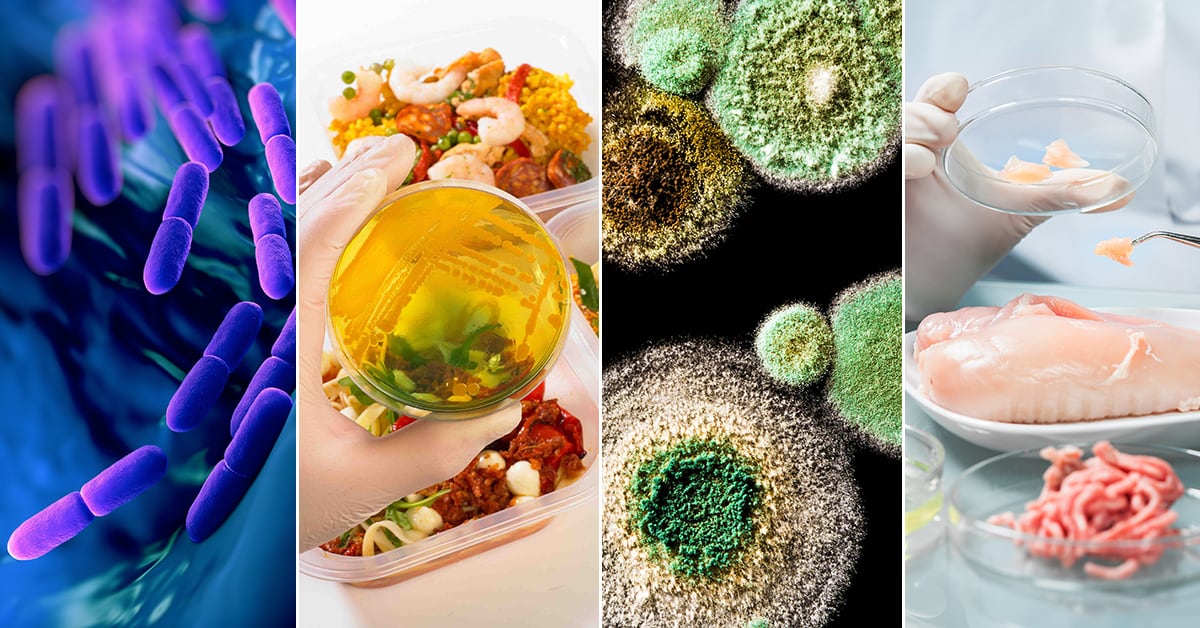It was revealed earlier in 2024 that hospital admissions for Salmonella and E. coli had reached their highest level in decades. There’s no denying that food contamination poses a serious risk, not just to public health but also to food manufacturers’ businesses and reputations.
That’s why it is vital that companies address microbial contamination head-on, but it can be a complex challenge. Ensuring the safety and quality of food products is a multifaceted challenge that requires a deep understanding of both the potential microbial contaminants and the most effective methods to eliminate them.
Here, we provide an overview of the most challenging food types, the pathogens they are prone to, and the techniques and processes that have been developed to combat the threats.
Challenging food types and their pathogens
Certain food types are more susceptible to microbial contamination than others. For example, many natural materials such as herbs and spices can harbour various pathogens, particularly Salmonella, but increasingly shiga toxigenic E. coli, which are associated with some dried commodities due to agricultural practices used in their production, extensive handling, and the warm, humid conditions in which they are often grown.
Meat, poultry, and seafood are particularly vulnerable to E. coli, Salmonella, and Listeria contamination, while dairy products can be contaminated with pathogens such as Listeria, E. coli, Salmonella, Bacillus cereus, pathogenic clostridia and Campylobacter. These pathogens not only pose significant health risks but also threaten the integrity of food brands and their market positions.
Eliminating microbial contamination
To address these challenges, food manufacturers can employ a variety of techniques. Each approach has its own set of advantages and limitations, so it is important to choose the right option for the particular food type in question.
Thermal techniques
First is thermal pasteurisation This is a well-established method that involves heating food to a specific temperature to kill pathogens. While effective, it can also alter the taste, texture, and nutritional content of some foods. It is particularly suitable for dairy products.
It is also a relatively energy-intensive means of killing pathogens when used in high-volume applications, although advances in electric induction heating mean producers are able to use low-emissions, renewable energy sources and achieve around 90% to 95% efficiency- helping to cut waste.
Further methods of thermal pasteurisation include radio-frequency and microwave pasteurisation.
With radio frequency pasteurisation, which operates using the volumetric heating method, heat is generated throughout the product. It can be effective for thicker or denser foods like meat products. Similarly, microwave pasteurisation also uses volumetric heating. Subsequently, by heating food quickly and uniformly, microwave pasteurisation helps reduce the risk of over-processing and can preserve food quality. It is versatile and can be used for a wide range of products, but it calls for specialised equipment and careful process control.
Another approach is irradiation. This involves exposing food to ionising radiation, which destroys pathogens without significantly affecting the food’s physical properties. It is highly effective and is approved for use in the UK on seven different types of food - fruit, vegetables, cereals, bulbs and tubers, dried aromatic herbs, spices and vegetable seasonings, fish and shellfish, and poultry. Adoption of the technique remains limited, largely because producers are required to state on packaging labels when products have been irradiated, potentially affecting consumer perceptions of the goods.
Non-thermal techniques
High pressure processing (HPP) is a non-thermal pasteurisation process where a food product is subjected to an intense hydrostatic pressure treatment to inactivate pathogens, spoilage microorganisms and enzymes.
The technique can be great for improving the safety of food and beverage products and extending their shelf life. However, its impact can be affected by many factors including the intrinsic properties of the food such as its pH, water activity, fat content, protein content, mineral and sugar content, bacterial growth phase and the holding pressure and time combinations that are applied to it.
While HPP is highly effective, there are some alternative non-thermal technologies available, with the first of these being pulsed light. As a chemical free, surface preservation method where a material is subjected to very short pulses (of the order of milliseconds) of intense broad-spectrum white light, pulsed light can improve the effectiveness of the decontamination process. However pulsed light does have some limitations. The biggest of these concerns its susceptibility to the shadowing effect, where light can’t reach the complete surface of a product, particularly those with folds and ridges that can shield organisms. The technology is also ineffective against bacterial spores, so other means are required to control spore-forming organisms in HPP-treated products, such as formulation control.
Next there is UV-C light exposure. This can be effective in killing microorganisms on food surfaces and packaging. This method is non-thermal and does not minimally impact the food’s sensory qualities, making it suitable for delicate items like strawberries. However, its effectiveness is limited to surface contamination.
Power ultrasound is another useful technique, where ultrasonic waves are used to process food. Its main benefit includes enabling manufacturers to speed up processes, whether that’s the pace of beverages lines, improving extraction time, reducing cleaning cycles or minimising hydration time. However, users need to be aware of its limitations, where high power ultrasound can cause some adverse physical and chemical effects on foods, and free radicals generated due to cavitation, which may result in lipid oxidation accompanied by off-flavours and odours.
Finally, another effective option is cold plasma treatment. In this instance man-made plasma can be generated at low temperatures typically by applying a voltage to a gas, which can then bring about an abundance of highly reactive chemical species capable of inactivating a wide range of microorganisms including food borne pathogens and spoilage organisms.
Cold plasma treatment offers notable benefits for some food applications including the disinfection of surfaces in particular equipment, packaging and food contact surfaces, but users need to be aware of some of its constraints that include the possible degradation of some pesticides and enzymes.
Chemical treatments are sometimes used to inactivate pathogens on products including fresh produce and dried commodities, such as spices, nuts and seeds, but are also sometimes used as interventions in meat production (e.g. lactic acid sprays). Such treatments may utilise an array of biocidal chemicals, ranging from chlorine and peracetic acid washes of fresh produce, to gaseous ethylene oxide, ozone, chlorine dioxide or acetic acid. The use of some chemical treatments, such as ethylene oxide, is prohibited in many countries due to concerns about the health effects of their residues and by-products.
With such a range of options available, it is essential to choose the right process and ensure it will be effective under the specific conditions present in the operation in question, and that’s where process validation comes into play.
The right tool for the job
Validation involves rigorous testing to confirm that the decontamination process consistently achieves the desired level of pathogen reduction.
At Campden BRI, we advocate for a comprehensive validation strategy that includes protocols tailored to the specific process in question and may include traditional heat penetration/temperature distribution studies, microbiological challenge testing, and continuous monitoring and reassessment.
Different foods and processes require tailored validation protocols. Typically, these will involve using probes and sensors to measure critical process parameters - most notably temperatures - to provide reassurance that the contamination threat has been removed.
For instance, the complexity of validating a heat pasteurisation process for milk differs significantly from validating UV-C exposure for spices. Each validation protocol must consider factors such as product composition, packaging, and processing environment, so there is no one-size-fits-all solution.
Challenge testing involves deliberately inoculating food with a known quantity of pathogens, or with a qualified surrogate organism if testing is carried out in the factory and then applying the decontamination process to measure its effectiveness. This helps identify any potential weaknesses in the process and provides data to optimise conditions. By measuring real-world outcomes under realistic “worst case” process conditions (the least severe conditions to which the product will realistically be exposed during normal processing) rather than relying on modelling, operators have an extra level of reassurance that the decontamination method is effective in both design and application.
It is important to note that process validation is not a one-time event. Continuous monitoring and periodic reassessment are essential to account for variations in raw materials, processing conditions, and equipment performance. Only by implementing a robust quality management system can a producer ensure ongoing compliance and safety.
Safety aligned with business objectives
As the recent rise in hospital admissions for foodborne illnesses starkly illustrates, the fight against microbial contamination is far from over. And there is no question that food manufacturers must remain vigilant and proactive in defending against the threat.
By employing the latest technologies and rigorous validation practices, producers can achieve uncompromising levels of safety and compliance in a way that is efficient both in terms of energy used and cost.
However, when it comes to food safety, it is not just the impact of processing that food manufacturers need to think, but the whole risk management process. This includes everything from good agricultural practices and ingredient/supplier management right through to product formulation, HACCP and more, which are all areas that Campden BRI is vastly experienced in supporting and advising customers on.
At Campden BRI, we are committed to supporting the industry in this vital endeavour, providing the expertise and resources to help protect not only public health but also business’ reputations and finances.




